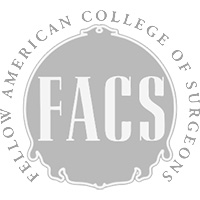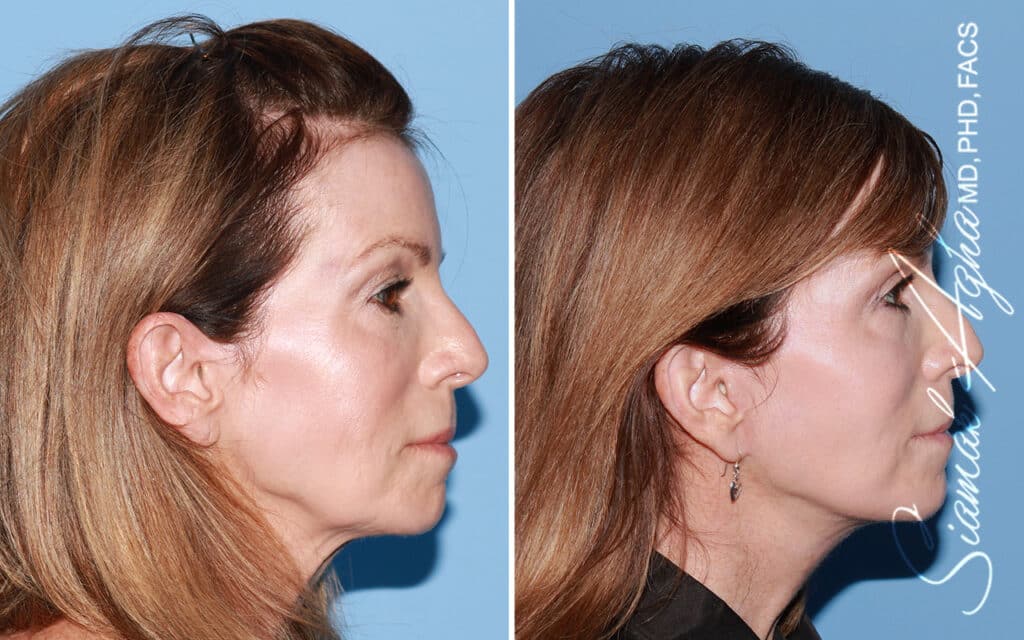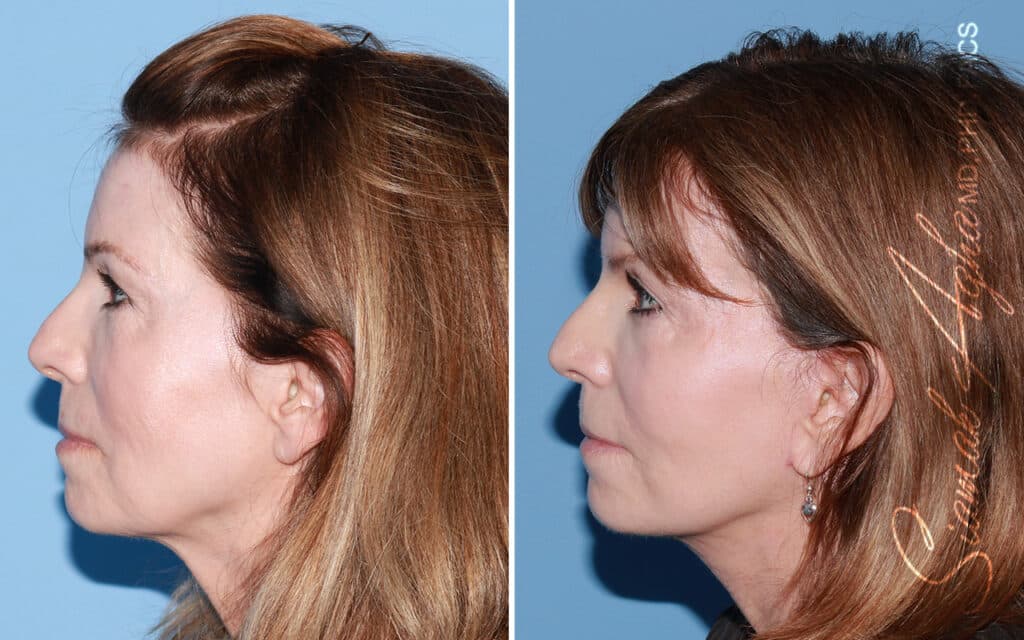Deep Plane Facelift Newport Beach
– NEWPORT BEACH, CA –






The deep plane facelift has become a popular facelift choice of many plastic surgeons and patients in the recent years. But did you know that the deep plane facelift was invented over 30 years ago by Renowned Plastic Surgeon, Dr. Sam Hamra, who named it the composite facelift!
Popular for shaving decades off of women’s aging faces, the deep plane facelift is becoming a favorite among women because it produces a natural look.
A deep plane facelift is a cutting-edge procedure in cosmetic surgery, targeting the signs of aging by working on the deeper tissues of the face. This technique focuses on the release of anchoring ligaments of face, elevation of deeper facial muscles and fat layers to achieve a tension-free effect that looks natural and youthful.
Patients often report looking years younger after the surgery. To understand how this technique can rejuvenate your appearance, schedule a consultation with Dr. Agha.
What is a Deep Plane Facelift?
The deep plane facelift is an advanced facelift technique that elevates your superficial musculoaponeurotic system (SMAS) and the deeper muscle layer of your face. It releases ligaments that normally prevent the deeper layer from being restored to its natural position.
The skin, muscle, and fat layers of your face are all lifted together, resulting in less tension and a more natural appearance.
Given the complete release of the deep ligaments of the face, the deep plane facelift gives longer-lasting results.
In deep plane facelift procedures, the technique is distinctively more comprehensive compared to other facelift surgeries. It involves a careful repositioning of facial tissues, which is meticulously executed by skilled plastic surgeons.
This approach allows for a holistic enhancement of facial features, targeting not just superficial layers, but the foundational structures of the face. The deep plane facelift technique is particularly effective in rejuvenating the face with results that look natural and harmonious, aligning seamlessly with the unique contours of each patient’s facial structure.
Deep Plane Facelift vs. Traditional SMAS Facelift: What’s the Difference?
The Deep plane facelift differs from traditional procedures by focusing on the mobile face. The face can be arbitrary divided into front (mobile) and side (immobile) segments. The deep plane facelift works on the mobile facial muscles that are deep to the facial skin and fat. By lifting and repositioning these deeper structures, the procedure has the ability to provide longer-lasting and more natural-looking results.
The most distinct characteristic separating this procedure from all other facelifts is how the surgeon moves the tissues under the skin. There are two distinguishing factors of the Deep plane facelift. First, there is elevation of the midface (the cheek). This provides lift and balance. With a traditional SMAS facelift, the midface is not addressed as ligaments preventing midface movement are not released.
Second, the Deep plane facelift keeps the area under the eyes from looking hollow by lifting the cheeks up and back. While other techniques are also employed during the deep plane facelift, these two movements are the primary defining factors that separate this type of facelift from more traditional methods.
Deep plane facelift surgeons often employ advanced surgical procedures to deliver more natural-looking and long-lasting results. This expertise involves a detailed understanding of facial anatomy and a refined surgical technique that differentiates them from traditional SMAS facelift surgeons.
Their approach is more intricate, addressing the deeper layers of the face to achieve a more youthful and rejuvenated appearance without the tell-tale signs of surgery. A deep plane facelift surgeon’s specialized skills are crucial in managing the complex structures of the face during these sophisticated surgical procedures.
The History of the Deep Plane Facelift
The history of facelift procedures dates back to ancient times when early civilizations used rudimentary methods to enhance facial aesthetics. However, modern facelift surgery began to take shape in the early 20th century, with surgeons pioneering techniques to restore youthfulness to the face and neck. As techniques evolved, surgeons recognized the importance of not just tightening the skin but also repositioning underlying tissues to achieve more natural-looking results. The composite facelift procedure, known today as the deep plane face and neck lift, was developed by renowned Plastic Surgeon Dr. Sam T. Hamra in 1990. This technique has revolutionized facial rejuvenation by addressing multiple aspects of aging rather than focusing only on the surface appearance of the skin.
Benefits of a Deep plane Facelift
There are many benefits of a Deep plane facelift when compared to traditional techniques. Many patients choose this procedure because it offers much better overall results than traditional facelifts. Deep plane facelifts can give you:
- Natural Results: One of the key benefits of a Deep plane facelift is the ability to create more natural-looking results. By addressing multiple layers of the face, including muscles and fat pads, a Deep plane facelift can provide a more comprehensive rejuvenation. Many patients prize this technique because, unlike older facelift procedures, it offers far more natural outcomes that do not highlight the fact that a patient has undergone surgery.
- Longevity: Due to its multi-layered approach, a Deep plane facelift often provides longer-lasting results when compared to a traditional facelift. The deeper structural changes made during a Deep plane facelift can help maintain the rejuvenated appearance for an extended period. Many Deep plane facelifts last for as much as 15 years without significant signs of aging.
- Finer scars: The deep plane technique elevates the facial structures as one unit, resulting in a tension-free closure. This reduces the tension on the skin closure and results in thinner scars.

How Is a Deep Plane Facelift Done?
The deep plane facelift begins similarly to other facelifts.
After incisions are made in front and back of your ear, the facial skin is partially lifted off of the SMAS layer of the face up to a line joining the corner of your eye and the angle of your jaw. At this junction, the SMAS layer is incised and the dissection is performed under the superficial facial muscles that are responsible for animation and facial movement. At this plane, ligaments that anchor the SMAS to the bone are also released. This gives the surgeon ability to lift and secure the mobile face higher at its natural position. The procedure is completed by suspending the deeper muscle layer and suturing it to the tissue around the ear.
Following repositioning of the deeper layer, the excess skin is trimmed and the skin incision is closed.
How Much Do Deep Plane Facelifts Cost?
When considering a deep plane facelift, one of the key factors is the cost of the procedure.
The deep plane facelift cost can vary widely depending on several factors, including the complexity of the surgery, the surgeon’s expertise, and the geographic location of the clinic.
On average, the cost for a deep plane facelift ranges between $40,000 to $60,000. This price variation reflects the individualized nature of the procedure, as each surgery is tailored to the specific needs and goals of the patient.
It’s important to discuss the cost with your surgeon during the initial consultation to get a more accurate estimate based on your unique case. Keep in mind that this cost typically reflects the surgeon’s fees, anesthesia, facility costs, and post-operative care.
How Should You Recover?
Among all facelift types, the deep plane facelift typically has the longest recovery period.
Right after the surgery, you’ll experience deep swelling and bruising of your entire face. This can last for several days and only entirely subside after two weeks.
Get Your Deep Plane Facelift at Los Angeles and Orange County
If you are considering a facelift with natural-looking results, then the deep plane facelift is an excellent choice. Its tension-free technique gives you an effortlessly youthful appearance that can last for more than a decade.
Schedule your consultation with Dr. Agha now to know if a deep plane facelift will work for you.





